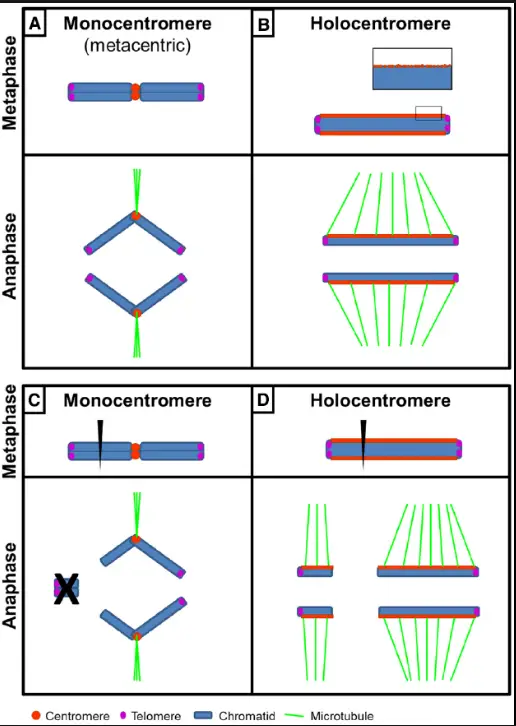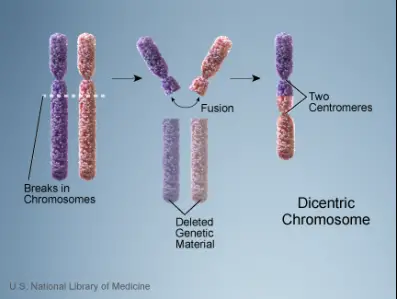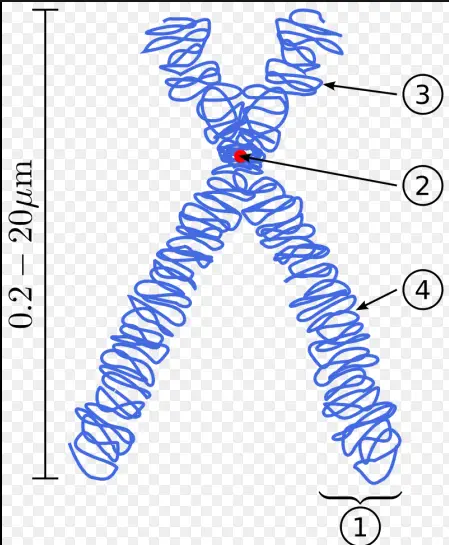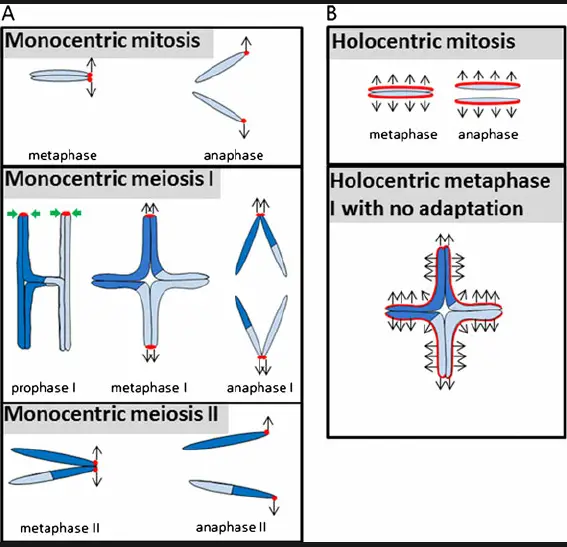Chromosomes are integral components of genetic material within every cell, playing a crucial role in the division and functioning of cells across all living organisms. They vary in number, structure, and types across species, each carrying specific genetic information vital for survival and reproduction. The structure of chromosomes can significantly influence their function and stability, affecting both normal cellular activities and genetic integrity.
Monocentric chromosomes have a single centromere, dicentric chromosomes possess two, and polycentric chromosomes feature multiple centromeres. These structural variations impact how chromosomes are pulled apart during cell division, influencing genetic stability and organism development. Understanding these differences is essential for advancing genetic research and medical science.
Each type of chromosome structure presents unique challenges and advantages in genetic processes. The distinctions between monocentric, dicentric, and polycentric chromosomes not only underscore their biological functions but also highlight the evolutionary adaptations that have optimized cellular division and genetic transmission in various organisms.

Chromosome Basics
Definition and Function
Chromosomes are thread-like structures located within the nucleus of animal and plant cells. Composed of protein and a single molecule of deoxyribonucleic acid (DNA), they carry genetic information that dictates everything from hair color to susceptibility to diseases. Each chromosome is made up of DNA tightly coiled many times around proteins called histones that support its structure.
Chromosome Structure Overview
Chromosomes vary in size and shape among organisms. In humans, chromosomes range from 50 million to 250 million base pairs of DNA and are distinguished by their length and the position of the centromere, which divides the chromosome into its characteristic “p” (short) and “q” (long) arms. This structural complexity ensures that during cell division, the genetic material is accurately copied and distributed to daughter cells.
Monocentric Chromosomes
Definition of Monocentric
Monocentric chromosomes have a single, centrally located centromere. This typical centromere structure is crucial as it is the point where spindle fibers attach during cell division to pull sister chromatids apart.
Features and Characteristics
Monocentric chromosomes are the most common type found in eukaryotic organisms. The centromere in these chromosomes ensures that the chromosome is aligned correctly during cell division, allowing for equal distribution of genetic material. This singular centromere creates a clear primary constriction during the metaphase of cell division, making it visible under a microscope.
Role in Cellular Division
The role of a monocentric chromosome in cell division is pivotal. During mitosis, the centromere serves as the attachment point for spindle fibers. As the cell prepares to divide, the centromere holds the two sister chromatids (duplicated chromosomes) together until they are ready to be pulled apart and segregated into the daughter cells. This precise control prevents genetic errors during cell division, which could lead to disease.

Dicentric Chromosomes
Definition of Dicentric
Dicentric chromosomes are abnormal structures containing two centromeres. Unlike the standard single centromere seen in monocentric chromosomes, this dual presence can lead to complications during cell division.
Characteristics and Formation
Dicentric chromosomes typically form as a result of errors in DNA repair or misalignment during genetic recombination. Their formation can be induced by certain types of genetic damage or when two chromosome fragments, each with a centromere, fuse together inappropriately.
Challenges and Consequences
The presence of two centromeres often creates a scenario where the chromosome is pulled in two different directions during cell division, leading to chromosome breakage or loss. This instability can result in cell cycle arrest or apoptosis, and if cells do survive, they may carry major genetic abnormalities that can lead to diseases such as cancer.
Polycentric Chromosomes
Defining Polycentric Chromosomes
Polycentric, or holocentric, chromosomes are those with multiple centromeres scattered along their length. Unlike the typical centromere configuration, these multiple points of attachment allow for more evenly distributed tension during cell division.
Unique Features
The unique structure of polycentric chromosomes provides an advantage under certain conditions, such as in organisms exposed to rapid environmental changes. This structure allows for greater flexibility and distribution of force during cell division, which can reduce the likelihood of breakage under stress.
Examples and Occurrences
Polycentric chromosomes are rare and are primarily found in certain species of plants and invertebrates. For example, the nematode Caenorhabditis elegans is a well-studied organism that possesses these types of chromosomes. Studies on these organisms help scientists understand how chromosomes adapt to different ecological and evolutionary pressures.

Comparative Analysis
Comparing Structure and Function
The structure of a chromosome can greatly influence its function within a cell. Monocentric chromosomes, with their single centromere, are designed for straightforward separation during cell division, minimizing complications. Dicentric chromosomes, on the other hand, contain two centromeres that can potentially pull a chromosome apart if both are active during division. Polycentric chromosomes are equipped with multiple centromeres, which distribute the tension of cell division across a larger area, reducing the risk of breakage.
These structural differences directly affect how chromosomes behave during the critical processes of mitosis and meiosis. Monocentric chromosomes are generally more stable, while dicentric ones are prone to malfunctions unless one centromere becomes inactive. Polycentric chromosomes offer a unique advantage in organisms that require rapid cell division across varied and changing conditions.
Impact on Genetic Stability
Chromosome structure is a key factor in maintaining genetic stability. Monocentric chromosomes, the most common structure, provide stability by ensuring a clear path for chromosome segregation. Dicentric chromosomes, however, introduce instability due to the potential for missegregation and chromosome breakage, which can lead to genetic disorders or cancer. Polycentric chromosomes can provide enhanced stability in certain environments by spreading the mechanical stress of cell division across multiple centromeres, thus preventing the typical failure points seen in other structures.
Evolutionary Significance
The evolution of different chromosomal structures highlights the adaptability of life forms to their environments. Monocentric chromosomes have been incredibly successful across a wide range of eukaryotic life, suggesting that this structure offers a significant evolutionary advantage in terms of replication and genetic integrity. The appearance of dicentric and polycentric chromosomes may represent evolutionary experiments where organisms adapt to niche environments or high-stress conditions that favor unusual cell division mechanics.
Research and Studies
Key Studies on Chromosome Structures
Numerous studies have focused on understanding the implications of chromosome structure for genetic health and stability. Research has shown that abnormalities in chromosome structure can lead to a wide array of genetic disorders. For instance, studies on cancer cells often reveal the presence of dicentric chromosomes, which contribute to the genetic instability characteristic of cancerous growths. Additionally, research on organisms with polycentric chromosomes, like certain insects and plants, provides insights into how these structures can confer advantages in harsh environments.
Recent Findings and Developments
Recent advancements in genetic research have shed light on how changes in chromosome structure can affect an organism’s evolution and adaptability. Innovative imaging techniques now allow biologists to observe chromosomes in real-time during cell division, helping to uncover how different centromere structures behave under cellular stress. Furthermore, the development of CRISPR-Cas9 gene-editing technology has opened new pathways for directly studying the functions and implications of specific chromosomal arrangements in live organisms.
Applications and Implications
Genetic Research Applications
The study of chromosome structures has profound implications for genetic research. Understanding how different centromere structures affect cell division and genetic stability can help scientists develop targeted therapies for diseases that involve chromosomal abnormalities, such as cancer and genetic disorders. Additionally, this knowledge aids in the creation of genetically modified organisms (GMOs) that are more resilient to environmental stressors, potentially leading to more robust agricultural products.
Medical and Biotechnological Implications
In the medical field, insights into chromosome structure can lead to improved diagnostic tools and treatments for genetic diseases. For example, identifying the presence of dicentric chromosomes can help diagnose certain cancers early, improving treatment outcomes. In biotechnology, engineering organisms with customized chromosome structures could produce novel biological products or improve the efficiency of existing ones, such as biofuels or pharmaceuticals.
Frequently Asked Questions
What are monocentric chromosomes?
Monocentric chromosomes contain a single centromere, which is the primary constriction point where spindle fibers attach during cell division. This structure is typical in most eukaryotic organisms and is crucial for the accurate segregation of chromosomes.
How do dicentric chromosomes form?
Dicentric chromosomes, which possess two centromeres, usually form through aberrations in cell division or as a result of genetic damage. They can lead to cell division errors and are often unstable unless one of the centromeres becomes inactivated.
What makes polycentric chromosomes unique?
Polycentric, or holocentric, chromosomes have multiple centromeres scattered along their length, allowing for more flexible spindle attachment points during cell division. This can confer advantages in certain environmental conditions and is seen in a few animal and plant species.
How do chromosome structures affect genetic stability?
The structure of a chromosome influences its behavior during mitosis and meiosis, which in turn affects genetic stability. Variations in centromere structure can lead to different risks of chromosomal breakage and missegregation, impacting an organism’s overall genetic health.
Conclusion
The study of different chromosome structures, from monocentric to polycentric, is more than an academic pursuit; it is crucial for understanding fundamental biological processes and their implications in health and disease. The distinctions between these chromosome types reflect the complexity of evolutionary biology and the delicate balance required for cellular and genetic stability.
As research continues, the insights gained from studying these chromosomal differences will likely contribute to breakthroughs in genetic engineering, disease treatment, and understanding evolutionary biology. This deeper comprehension opens pathways to innovations that could transform medical and biological sciences.

